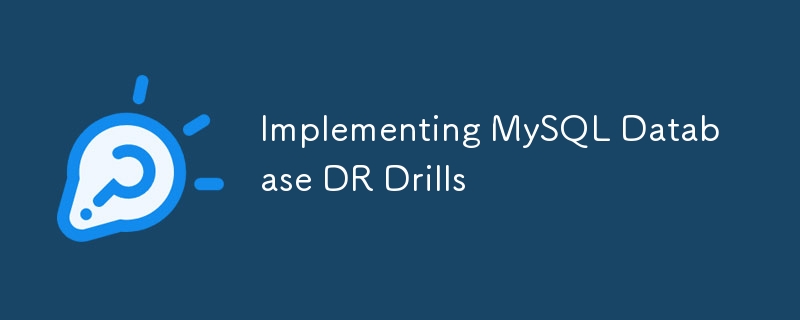Disaster recovery drills need to clarify goals, prepare the environment, perform observations, analyze and optimize. 1. Clarify verification of the targets such as main library downtime switching, data consistency, application connection, time-consuming, etc. and select failure scenarios. 2. In the off-peak preparation drill environment, ensure normal replication, consistent configuration, complete backups and formulate a rollback plan. 3. Observe master-slave delay, data consistency, switching time, log output, client behavior and tool logic during execution. 4. After the drill, the analysis results form report update monitoring, scripts, documents, contacts and other continuous optimization processes to improve reliability.

MySQL database disaster recovery drills (DR Drills) are an important part of ensuring high availability of the system. After building master-slave replication or clusters, many teams often ignore regular disaster recovery drills. They do not find that the plan is incomplete, data synchronization abnormality, or the switching process is stuck when the failure occurs.

1. Clarify the drill goals and scenarios
Before you start, you must first clarify what you want to verify through this drill. Common disaster recovery drill goals include:
- Can I automatically/manually switch to the backup library after the main library is down
- Whether data is lost during switching
- Is the data consistency of the backup library reliable?
- Can the application layer connect to the new main library normally?
- How long does the entire switching process take?
You can choose different simulated failure scenarios, such as network interruption, main library crash, disk full load, etc. The response methods of each scenario are slightly different, and it is recommended to cover them step by step in stages.

2. Prepare for the drill environment
It is best to conduct real drills during off-peak hours to avoid affecting online business. If there is no special testing environment, you can consider the following methods:
- Small environments that use cloned database structure and part of data
- Build a backup and recovery environment consistent with production
- Rapid deployment of MySQL instances with Docker
Either way, you need to ensure:

- Master-slave replication status is normal
- binlog format and GTID configuration are the same
- The backup mechanism is complete and recoverable
In addition, it is also important to prepare emergency rollback plans in advance. In case of serious problems found during the drill, you can quickly restore them to the original state.
3. Perform drills and observe key indicators
During the execution of the drill, focus on the following aspects:
- Master-slave delay: Use
SHOW SLAVE STATUSto check if there is a delay - Data consistency: You can compare the master-slave table data through the checksum tool
- Failover time: Record the time from the occurrence of the failure to the service recovery
- Log output: Check whether there are any exceptions in the error log and slow query log
- Client behavior: Whether the application reconnects successfully, and whether there is any error
If you use MHA, Orchestrator and other tools, pay attention to whether the switching logic meets expectations. If it is a manual switch, be sure to follow the Standard Operation Process (SOP) step by step.
4. Analyze the results and optimize the plan
After the drill, organize the following content:
- Is the actual switching time within SLA range?
- Is there any data loss or inconsistency
- Which steps are wrong or take longer
- Is the tool working as expected
- Whether to update documents or train personnel
It is recommended to form a brief report after each drill and update the operation and maintenance manual and emergency plans accordingly. For example:
- Add monitoring alarm items
- Adjust the switch script parameters
- Supplementary manual confirmation process
- Update contact list and response process
The continuous optimization of this type of detail is more important than a one-time "running through".
Basically that's it. Disaster recovery drills are not one-time tasks, but a process that requires continuous polishing. Behind the seemingly simple switch, it actually involves the cooperation of multiple systems. The sooner the problem is discovered, the more you can reduce losses at critical moments.
The above is the detailed content of Implementing MySQL Database DR Drills. For more information, please follow other related articles on the PHP Chinese website!

Hot AI Tools

Undress AI Tool
Undress images for free

Undresser.AI Undress
AI-powered app for creating realistic nude photos

AI Clothes Remover
Online AI tool for removing clothes from photos.

Clothoff.io
AI clothes remover

Video Face Swap
Swap faces in any video effortlessly with our completely free AI face swap tool!

Hot Article

Hot Tools

Notepad++7.3.1
Easy-to-use and free code editor

SublimeText3 Chinese version
Chinese version, very easy to use

Zend Studio 13.0.1
Powerful PHP integrated development environment

Dreamweaver CS6
Visual web development tools

SublimeText3 Mac version
God-level code editing software (SublimeText3)
 Handling NULL Values in MySQL Columns and Queries
Jul 05, 2025 am 02:46 AM
Handling NULL Values in MySQL Columns and Queries
Jul 05, 2025 am 02:46 AM
When handling NULL values ??in MySQL, please note: 1. When designing the table, the key fields are set to NOTNULL, and optional fields are allowed NULL; 2. ISNULL or ISNOTNULL must be used with = or !=; 3. IFNULL or COALESCE functions can be used to replace the display default values; 4. Be cautious when using NULL values ??directly when inserting or updating, and pay attention to the data source and ORM framework processing methods. NULL represents an unknown value and does not equal any value, including itself. Therefore, be careful when querying, counting, and connecting tables to avoid missing data or logical errors. Rational use of functions and constraints can effectively reduce interference caused by NULL.
 Performing logical backups using mysqldump in MySQL
Jul 06, 2025 am 02:55 AM
Performing logical backups using mysqldump in MySQL
Jul 06, 2025 am 02:55 AM
mysqldump is a common tool for performing logical backups of MySQL databases. It generates SQL files containing CREATE and INSERT statements to rebuild the database. 1. It does not back up the original file, but converts the database structure and content into portable SQL commands; 2. It is suitable for small databases or selective recovery, and is not suitable for fast recovery of TB-level data; 3. Common options include --single-transaction, --databases, --all-databases, --routines, etc.; 4. Use mysql command to import during recovery, and can turn off foreign key checks to improve speed; 5. It is recommended to test backup regularly, use compression, and automatic adjustment.
 Calculating Database and Table Sizes in MySQL
Jul 06, 2025 am 02:41 AM
Calculating Database and Table Sizes in MySQL
Jul 06, 2025 am 02:41 AM
To view the size of the MySQL database and table, you can query the information_schema directly or use the command line tool. 1. Check the entire database size: Execute the SQL statement SELECTtable_schemaAS'Database',SUM(data_length index_length)/1024/1024AS'Size(MB)'FROMinformation_schema.tablesGROUPBYtable_schema; you can get the total size of all databases, or add WHERE conditions to limit the specific database; 2. Check the single table size: use SELECTta
 Handling character sets and collations issues in MySQL
Jul 08, 2025 am 02:51 AM
Handling character sets and collations issues in MySQL
Jul 08, 2025 am 02:51 AM
Character set and sorting rules issues are common when cross-platform migration or multi-person development, resulting in garbled code or inconsistent query. There are three core solutions: First, check and unify the character set of database, table, and fields to utf8mb4, view through SHOWCREATEDATABASE/TABLE, and modify it with ALTER statement; second, specify the utf8mb4 character set when the client connects, and set it in connection parameters or execute SETNAMES; third, select the sorting rules reasonably, and recommend using utf8mb4_unicode_ci to ensure the accuracy of comparison and sorting, and specify or modify it through ALTER when building the library and table.
 Aggregating data with GROUP BY and HAVING clauses in MySQL
Jul 05, 2025 am 02:42 AM
Aggregating data with GROUP BY and HAVING clauses in MySQL
Jul 05, 2025 am 02:42 AM
GROUPBY is used to group data by field and perform aggregation operations, and HAVING is used to filter the results after grouping. For example, using GROUPBYcustomer_id can calculate the total consumption amount of each customer; using HAVING can filter out customers with a total consumption of more than 1,000. The non-aggregated fields after SELECT must appear in GROUPBY, and HAVING can be conditionally filtered using an alias or original expressions. Common techniques include counting the number of each group, grouping multiple fields, and filtering with multiple conditions.
 Implementing Transactions and Understanding ACID Properties in MySQL
Jul 08, 2025 am 02:50 AM
Implementing Transactions and Understanding ACID Properties in MySQL
Jul 08, 2025 am 02:50 AM
MySQL supports transaction processing, and uses the InnoDB storage engine to ensure data consistency and integrity. 1. Transactions are a set of SQL operations, either all succeed or all fail to roll back; 2. ACID attributes include atomicity, consistency, isolation and persistence; 3. The statements that manually control transactions are STARTTRANSACTION, COMMIT and ROLLBACK; 4. The four isolation levels include read not committed, read submitted, repeatable read and serialization; 5. Use transactions correctly to avoid long-term operation, turn off automatic commits, and reasonably handle locks and exceptions. Through these mechanisms, MySQL can achieve high reliability and concurrent control.
 Connecting to MySQL Database Using the Command Line Client
Jul 07, 2025 am 01:50 AM
Connecting to MySQL Database Using the Command Line Client
Jul 07, 2025 am 01:50 AM
The most direct way to connect to MySQL database is to use the command line client. First enter the mysql-u username -p and enter the password correctly to enter the interactive interface; if you connect to the remote database, you need to add the -h parameter to specify the host address. Secondly, you can directly switch to a specific database or execute SQL files when logging in, such as mysql-u username-p database name or mysql-u username-p database name
 Managing Character Sets and Collations in MySQL
Jul 07, 2025 am 01:41 AM
Managing Character Sets and Collations in MySQL
Jul 07, 2025 am 01:41 AM
The setting of character sets and collation rules in MySQL is crucial, affecting data storage, query efficiency and consistency. First, the character set determines the storable character range, such as utf8mb4 supports Chinese and emojis; the sorting rules control the character comparison method, such as utf8mb4_unicode_ci is case-sensitive, and utf8mb4_bin is binary comparison. Secondly, the character set can be set at multiple levels of server, database, table, and column. It is recommended to use utf8mb4 and utf8mb4_unicode_ci in a unified manner to avoid conflicts. Furthermore, the garbled code problem is often caused by inconsistent character sets of connections, storage or program terminals, and needs to be checked layer by layer and set uniformly. In addition, character sets should be specified when exporting and importing to prevent conversion errors






